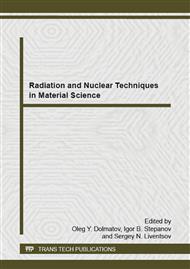p.3
p.7
p.11
p.16
p.21
p.26
p.30
p.34
p.38
Effect of Hydrogen on Conductivity of Metals
Abstract:
The work considers the application of a magnetic spectrometer (MS) for analyzing the hydrogenation of metals (particularly, titanium and copper). Therefore, for the sake of increasing the sensitivity of the magnetic spectrometer, the following ratios are introduced: (ΔU/U)/(Δd/d) (where ΔU/U is the relative change of the MS signal and Δd/d is the relative change in the thickness of a sample), (ΔU/U)/(Δδ/δ) (where Δδ/δ is the relative change in the depth of eddy current penetration into metal) and (ΔU/U)/(ΔS/S) (where ΔS/S is the relative change in the area of sample). These parameters allow to eliminate or reduce the error in determining the conductivity value. Parameter β that is equal to the product of the sample area and the inverse value of eddy current penetration depth into metal corresponds to the effectiveness of the current penetration into metal. The authors derived a formula that ties the electric conductivity of metal to the number of implanted hydrogen atoms, which allows determining the composition of titanium hydride at different depth of metal.
Info:
Periodical:
Pages:
21-25
Citation:
Online since:
January 2015
Authors:
Price:
Сopyright:
© 2015 Trans Tech Publications Ltd. All Rights Reserved
Share:
Citation:


